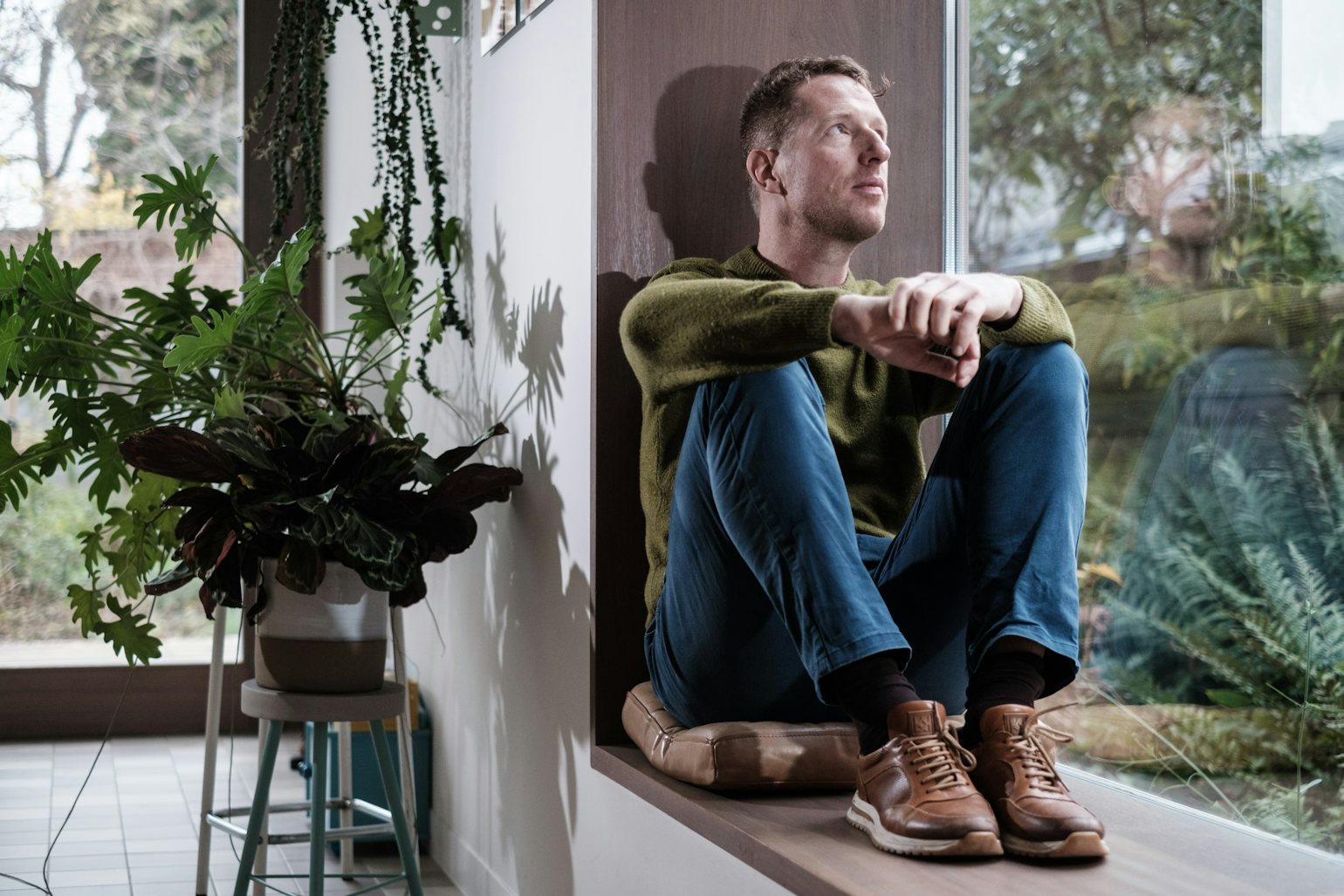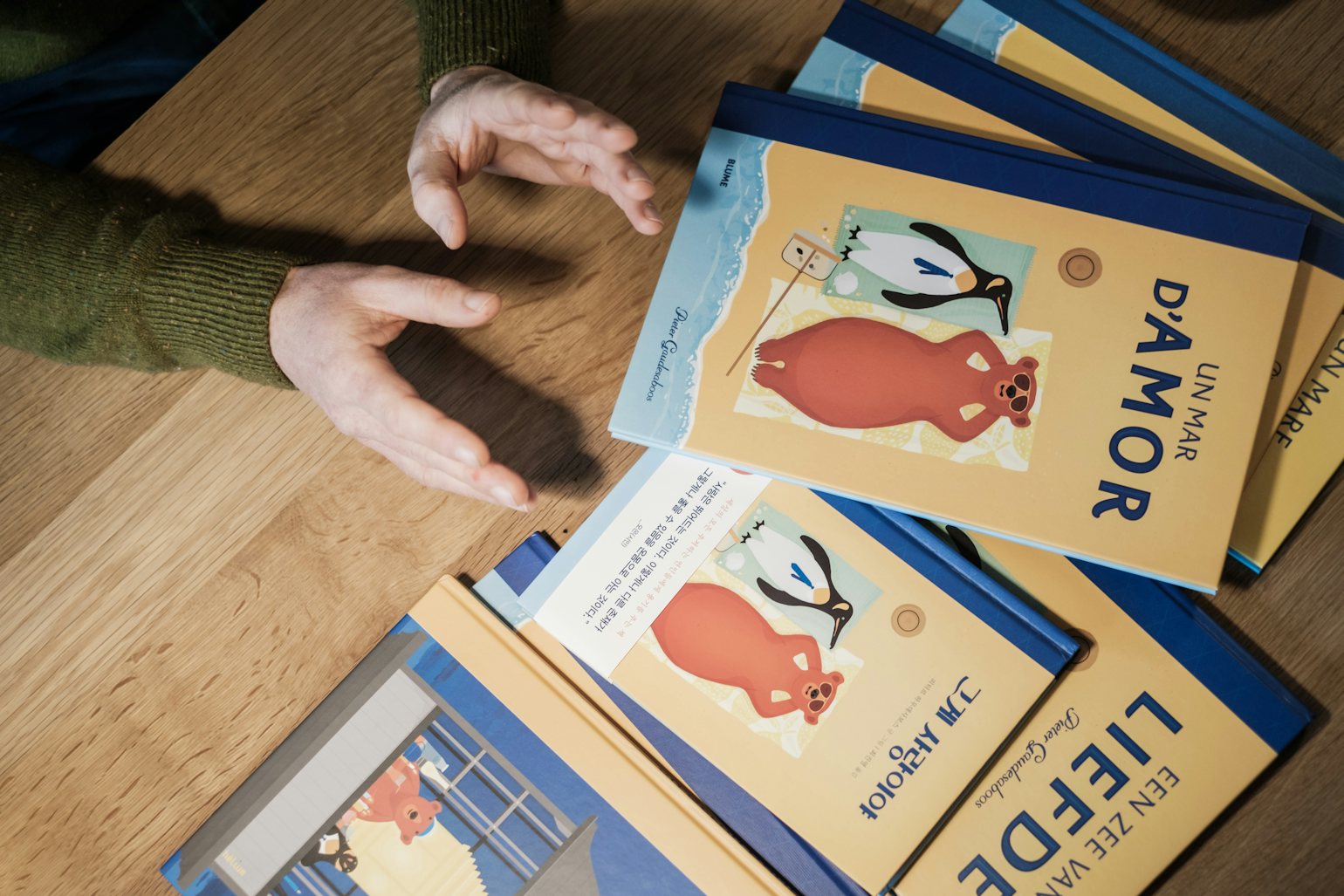“My books are different, edgy, and that’s my forte”
A year ago, ‘A Sea of Love’ made it onto the shortlist of the inaugural Boon for children’s and young adult literature. Pieter Gaudesaboos would end up winning both the jury and readers’ prizes. “It felt like an oeuvre prize”, Pieter says. “But I also see it as an accolade for my publisher, Lannoo, which has had faith in me and my work from the outset.”

What are the ingredients that make ‘A Sea of Love’ so successful?
You can never tell while you’re making a book. There’ll be times when I’m thinking: this is going to do really well. But then shortly afterwards I’ll be hit by doubt again.
What I like about the success of ‘A Sea of Love’ is that it’s not obvious. It’s a fairly big tome with lots of variation in the layout and even a few blank pages, which isn’t what you expect from a picture book. But more than that: it’s about love between two boys, albeit in a subtle way. In our country that’s no longer a big deal, but it’s a different story elsewhere.
The book has been sold to nine countries. Is that a lot?
Oh yes. My previous books have each been translated into three or four other languages, often in small print runs. ‘A Sea of Love’ has been published in many more languages and in larger print runs, and now for the first time I have a German publisher, which had long been a dream of mine. It’s quite remarkable, actually: my German publisher established a new company especially for my book: Jakob Verlag.
She normally publishes cookbooks, but when she spotted my book in Frankfurt she fell in love with it and couldn’t get it out of her head. At first, Lannoo was a bit hesitant, not sure whether she was the right fit, but eventually they did team up with her. She may not have experience of publishing children’s books, but she’s incredibly enthusiastic and passionate. The German translation only came out in November; I’m curious to see how well it’s selling…
You can never tell while you’re making a book. There’ll be times when I’m thinking: this is going to do really well. But then shortly afterwards I’ll be hit by doubt again.

Literary prize
At the start of this year, you won the Boon for children’s and YA literature as well as the audience award in the same category. Has that played a big role in the book’s success?
It certainly played a part. ‘A Sea of Love’ came out in September 2021, and did all right, but not great. When the Boon shortlist was announced and then the award ceremony happened, it really took off.
And then of course there’s an element of luck. Other people on the Boon jury might have chosen another winner. Or when a beautiful YA novel is published at the same time as your book, your odds of winning decrease significantly. That’s what I thought when I saw the 2023 Boon shortlist.
That said, a prize doesn’t necessarily lead to higher sales and more translations. For example, back in 2008, Mieke Versyp, Sabien Clement and I received a Gouden Uil for ‘Linus’. That was a dark, heavier book, and the prize didn’t really have an impact on sales. ‘A Sea of Love’ is a warm story with cheerful drawings. It came out at the right time, I think: people are keen to forget their troubles for a bit.
‘A Sea of Love’ is a warm story with cheerful drawings. It came out at the right time, I think: people are keen to forget their troubles for a bit.
Does that mean that with ‘A Sea of Love’ you’ve finally created a bestseller?
Every year, I visit the international children’s book fair in Bologna, which is always very inspiring to me, as it is to many of my colleagues. The last time we were there, we wandered amongst the vast array of picture books and joked that maybe we ought to start making glitter books with unicorns in them, just so we’d have a bestseller.
And that’s what’s so remarkable about ‘A Sea of Love’: like all of my books, it’s quirky, with a bit of an edge. I used to think that a more mainstream approach might be more rewarding, but I see the success of this book as affirmation of being on the right track. My books are different, edgy, and that’s my forte. So with hindsight, I can say: ‘it pays to find your own voice’.
‘A Sea of Love’ appeals to a very broad readership.
Lots of people buy it as a baby gift, even though it’s targeted at 6 to 7-year-olds. But grown-ups are giving it to each other as well, and I’ve heard that it’s read to people in retirement homes. The story even works when I tell it to toddlers during my workshops. I think that’s because it’s actually a grown-up story, but with visuals that appeal to children. For me, a good book walks the line between commercially interesting and quirky. I think ‘A Sea of Love’ put me smack-bang on that line, and that’s why it works so well.

All of your books have been published by Lannoo. That’s another love story, it would appear. How did it all start?
I graduated with a degree in graphic design in 2002, when De Eenhoorn was in its heyday. They were the go-to publisher for anyone wanting to make artistic books. At the same time, Lannoo was trying to find its voice, and that made it the place where anything and everything was possible. They were looking for more experimental projects, and the timing was perfect for me.
I’d finished ‘Little Red Rag’, a visual experiment, which came out of my training as a designer and photographer. At the time, Lannoo published the stream-of-consciousness mixed-media books by Katy Couprie and Antonin Louchard (‘A Whole World, ‘In the Garden’, etc.). I loved those, and that’s why I contacted publisher Sofie Van Sande, who I’d bumped into once or twice. She asked me to hand her my manuscript at Sint-Pieters Station in Ghent, from where she commuted to work every morning. So there I was at the crack of dawn, terrified. She boarded the train with my envelope, and all I could do was wait. But not for long, because I heard back from her that evening: ‘We’re going for it’. I’d been thinking that I might have to wait weeks for an answer. But she was full of enthusiasm from the outset, as was a colleague and her boss, who spotted it on her desk later that same day.
I used to think that a more mainstream approach might be more rewarding, but I see the success of this book as affirmation of being on the right track.
Sofie is still your publisher. Would your career be any different without her?
Sometimes you hear, ‘you don’t want to stay with the same publisher’. But to be honest, I still feel really good about it. I make one book a year, together with Sofie, and it’s always a very friendly and trusting process. I tend to come up with crazy ideas, and I’ve had the chance to make books in the shape of a petit-beurre biscuit and a toolbox, a book with holes in it… She never says no out of hand; she’ll always try to figure out whether it’s feasible. I think it would be very difficult to produce a book with a publisher other than Sofie. Of course, she’s not my best friend. We often find ourselves on opposite sides of a negotiating table, but we always bring a lot of humour to it.
But my career has also been shaped by support from Flanders Literature. The grants have made it possible for me to work on my books all these years, giving me the chance to experiment, make mistakes and learn from them.”
The grants have made it possible for me to work on my books all these years, giving me the chance to experiment, make mistakes and learn from them.

Don’t play it safe
Since that first book, your work has evolved from photo collages to multi-layered picture books, to put it in a nutshell. How do you view that evolution?
I wouldn’t have the courage to make ‘Little Red Rag today, precisely because it was so experimental. Then again, starting with that book worked to my advantage. It allowed me to make my mark, without being burdened by expectations. That would be my tip for aspiring picture book makers: start by making the kind of book you really want to make; don’t think you have to play it safe, and don’t consciously work towards a particular norm.
When I started, getting published was the greatest reward – that was my ambition. After the first few books, I wanted international recognition, and I looked for collaborations with authors and various other ways of achieving that. Now, more than anything, I want to make books that are read by lots and lots of people. I want to make books that I would have liked to read as a child.
Are you making ‘better’ picture books now that you have children of your own?
I always thought that that didn’t come into it. After all, I used to read my books in schools, get the reactions from children during my workshops… But now that I have children of my own, I realise that there’s a difference. Now I know how parents look at books. I realise what it feels like – after a long day at work and then having to put dinner on the table at home – to read to your children at half past seven in the evening when they’re finally in bed. And that that’s different from reading your book to a classroom full of well-rested children.
Which of your books is most special to you?
The latest book is always special. But I would say it’s ‘A Sea of Love’. It brings everything together. All the ideas for my books are my own, but in this one I did everything myself, and that includes writing the script.
It may sound trivial to say ‘I make children’s books’, and perhaps it is. But ‘A Sea of Love’ is more than a beautiful book to me, because it’s actually saying something. I’m trying to tell a story that’s important to me and reach as many children as possible. So it’s cool that it’s this book that’s doing so well.